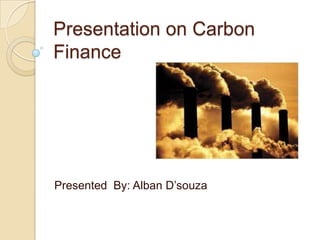
Carbon finance
- 1. Presentation on Carbon Finance Presented By: Alban D’souza
- 2. Carbon finance Carbon finance is a new branch of environmental finance. Carbon finance explores the financial implications of living in a carbon-constrained world, a world in which emissions of carbon dioxide and other green house gases (GHGs) carry a price.
- 3. Introduction Environmental consciousness is taking its shape in various dimensions in today’s complex business world. The five mega issues which are impacting the behaviour of companies and in turn their strategies are the Climate Change, Pollution/Health Consciousness, Globalization backlash, Energy Crunch and Erosion of Trust The finance sector is impacted because the world commands a hefty price for Carbon dioxide emissions and greenhouse gases (GHGs). This is the major reason why today’s environmental issues elate to the level of corporate financial strategy and policy involving CEOs, CFOs and BOD of companies. Hence, an understanding of carbon finance, role of the financial services sector and carbon trading (as other commodity trading) in climate/commodity exchanges by environment-conscious stakeholders in various industry value chains assumes significance in the context of environmental risk mitigation and adherence to climate change policies.
- 4. Climate Change and Industry Industries directly affected by climate change include Agriculture, Fisheries, Forestry, Health Care, Tourism, Water, Real Estate and Insurance[2]. GHG emissions from agricultural activities account for about 15% of global GHG emissions. Weather developments may also have negative consequences for carbon-regulated industries such as electric power, Oil and gas producers.
- 5. Joint Implementation and Clean Development Mechanism With the entry into force of the Kyoto Protocol on February 16, 2005, more than one hundred and forty countries agree to work together to fight global climate change. The thirty six industrialized countries that ratified the Protocol - namely Canada, Japan, members of the European Union, as well economies in transition from Central and Eastern Europe – agree to put in place policies and measures to collectively reduce 5 percent of their emissions between2008 to 2012 as measured against 1990 levels. To meet this binding commitment, industrialized countries have the option to reduce part of their emissions domestically, and they can also emission reductions from developing countries or from countries with economies in transition through Joint Implementation or International Emissions Trading. The Kyoto Protocol fulfils the commitment made by one hundred and eighty six countries under the UN Framework Convention on Climate Change (UNFCC) that industrialized countries – who are responsible for the vast majority of emissions that cause climate change – should take the first steps towards sustainable energy consumption, use of clean technologies and sustainable land management practices, which are needed to mitigate the impacts of climate change.
- 6. World Bank’s involvement in Carbon Finance The threat climate change poses to long- term development and the ability of the poor to move out from poverty is of particular concern to the World Bank. The carbon finance activities of the World Bank are a natural extension of the Bank’s mission to reduce poverty. The Bank makes every effort to ensure that poor countries can benefit from international responses to climate change including the emerging carbon market for GHG emission reductions.
- 7. The Bank has created several carbon funds. Who owns these funds? The World Bank manages several carbon funds and facilities comprised of public and private participants: Prototype Carbon Fund (PCF); Netherlands JI and Netherlands CDM Facilities; Community Development Carbon Fund (CDCF); Bio Carbon Fund; Italian Carbon Fund; Spanish Carbon Fund; Danish Carbon Fund; the Umbrella Carbon Facility (UCF); Carbon Fund for Europe (CFE); the Forest Carbon Partnership Facility (FCPF); and the Carbon Partnership Facility (CPF). These funds are public or public-private partnerships managed by the World Bank as a Trustee. They operate much like a closed-end mutual fund; they purchase greenhouse gas emission reductions from projects in the developing world or in countries with economies in transition, and pay on delivery of those emission reductions.
- 8. Work of Carbon Funds:
- 9. Main players in the Carbon market at this point in time Companies and governments are attracted to the various Carbon funds of the World Bank by the proven record of the World Bank in providing shareholders with Kyoto-compliant certified emission reduction assets at a guaranteed low price. Additional benefits for investors include the acquisition of high-value knowledge and intelligence on carbon finance and emerging national, regional and international markets.
- 10. Conclusion carbon market, playing key roles in the design and implementation of the Kyoto mechanisms since their inception. The Carbon Finance group develops and manages funds that invest in companies and projects involved in the reduction of greenhouse gas emissions and has managed over €850m to invest in carbon projects since 2005.
- 11. Thank You
